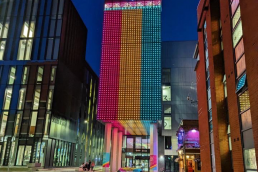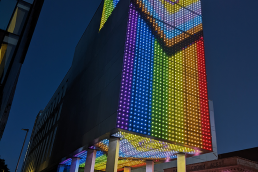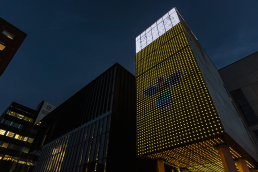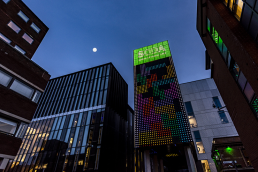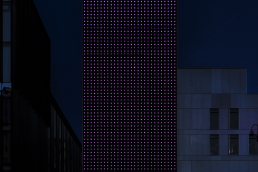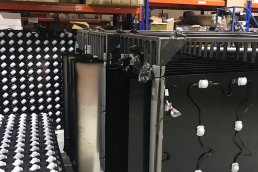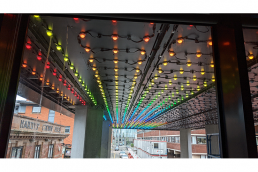This website uses cookies so that we can provide you with the best user experience possible. Cookie information is stored in your browser and performs functions such as recognising you when you return to our website and helping our team to understand which sections of the website you find most interesting and useful.
School of Digital Arts (SODA), Manchester Metropolitan University
ProjectSchool of Digital Arts (SODA), Manchester Metropolitan UniversityLocationManchester, UKArchitectFeilden Clegg Bradley StudiosLighting DesignerFeilden Clegg Bradley StudiosInstallerStudiotechMain ContractorKier GroupM&E ContractorDodd GroupSubmitted byStudiotech
School of Digital Arts (SODA) is a purpose-built, state-of-the-art interdisciplinary learning environment, supporting Greater Manchester’s creative and digital industries. Expressing creativity from the exterior, SODA’s four-storey digital media façade boldly announces its arrival in the city.
Studiotech supplied and installed 8059 individually addressable Traxon Archishape 2.0 dots, controlled by an e: cue control system. The SODA façade has many advanced features such as video-to-light pixel mapping, video import and visual automation tools.
With in-house training provided by Studiotech, the team at SODA now have the ability to upload their own content. Passing on the knowledge to the students and allowing them to showcase their creativity in the form of artwork and animation adorning the façade in lights.
Feilden Clegg Bradley Studios was careful to carry out a light pollution assessment (via lighting design practice LAPD), which Studiotech fully supported.
The success of the installation was largely down to careful planning and effective coordination between all associated trades from Main contractors; Kier construction, through to M&E Contractors; Dodd Group, the organisation on site was incredibly impressive and pivotal to the project’s success.
Based on typical light usage in media solutions being at around 25-30% of the total potential output, Studiotech estimates that the media façade at SODA has a total annual energy consumption of 9,580kWh per year. Similar energy usage of the average electric car that travels around 25,000 miles per annum. Total power used by all of the lights adds up to about 16kW. As the screen runs animation and video, a more realistic figure would be a third of this, or less, which is comparable to the power used by two kettles. Maximum impact with minimal consumption.
In terms of practicality, Studiotech completed a large proportion of work at its headquarters. A total of 132 powder-coated aluminium sheets were produced with laser-cut holes to allow the nodes to be installed off-site. Studiotech organised for the LED dots to be manufactured on specific strings to allow each panel to have its own allocated string of LEDs, making logistics and installation much more efficient.
Because there were so many large sheets to be transported to the site, Studiotech fabricated stillages to reduce space during transport whilst also keeping the lighting and associated cables protected from damage.
Another challenge was having all the power supplies installed internally for ease of access. For future maintenance reasons, it was collectively decided that all of the power and control components should be installed internally. This meant there were quite long runs of power and data that all needed to be connected to the correct devices
“It was extremely lucky for us, we’ve got this screen with the absolute perfect client whose job it is to story tell through digital media,” said Steve Wilby, Feilden Clegg Bradley.
The digital media façade is a carefully considered, well-designed element of the building which is essentially a blank canvas for the students at SODA to express their creativity.
The future talent of this very industry now has the tool to convey their artwork in the form of lighting at the heart of one of the world’s most innovative and creative cities.
